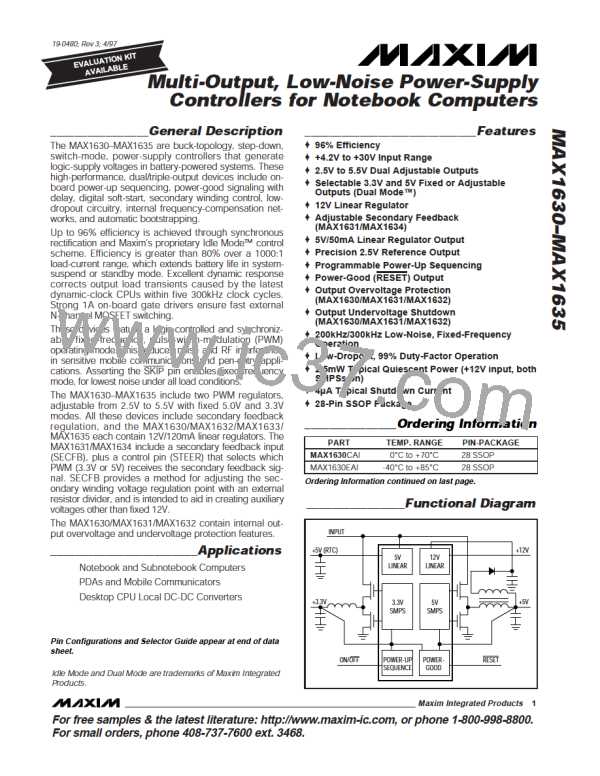Mu lt i-Ou t p u t , Lo w -No is e P o w e r-S u p p ly
Co n t ro lle rs fo r No t e b o o k Co m p u t e rs
0–MAX1635
Rectifier Diode D3
2
PD(upper FET)= (I
)
x R
x DUTY
DS(ON)
LOAD
(Transformer Secondary Diode)
The secondary diode in coupled-inductor applications
mus t withs ta nd flyb a c k volta g e s g re a te r tha n 60V,
whic h us ua lly rule s out mos t Sc hottky re c tifie rs .
Common silicon rectifiers, such as the 1N4001, are also
prohibited because they are too slow. This often makes
fast silicon rectifiers such as the MURS120 the only
choice. The flyback voltage across the rectifier is relat-
V
x C
RSS
IN
+ V x I
x f x
+ 20ns
IN
LOAD
I
GATE
2
PD(lower FET) = (I
)
x R
x (1 - DUTY)
DS(ON)
LOAD
DUTY = (V
+ V ) / (V - V )
Q2 IN Q1
OUT
where: on-state voltage drop V = I
x R
DS(ON)
ed to the V - V
difference, according to the trans-
Q_
LOAD
IN
OUT
former turns ratio:
C
= MOSFET reverse transfer capacitance
RSS
I
= DH driver peak output current capabil-
ity (1A typical)
V
= V
+ (V - V
) x N
GATE
FLYBACK
SEC
IN OUT
20ns = DH driver inherent rise/fall time
where: N = the transformer turns ratio SEC/PRI
V
= the ma ximum s e c ond a ry DC outp ut
voltage
Under output short-circuit, the MAX1633/MAX1634/
MAX1635’s synchronous rectifier MOSFET suffers extra
stress because its duty factor can increase to greater
than 0.9. It may need to be oversized to tolerate a con-
tinuous DC s hort c irc uit. During s hort c irc uit, the
MAX1630/MAX1631/MAX1632’s output undervoltage
shutdown protects the synchronous rectifier under out-
put short-circuit conditions.
SEC
V
OUT
= the primary (main) output voltage
Subtract the main output voltage (V
in this equation if the secondary winding is returned to
and not to ground. The diode reverse breakdown
rating must also accommodate any ringing due to leak-
age inductance. D3’s current rating should be at least
twice the DC load current on the secondary output.
) from V
OUT FLYBACK
V
OUT
To reduce EMI, add a 0.1µF ceramic capacitor from the
high-side switch drain to the low-side switch source.
Lo w -Vo lt a g e Op e ra t io n
Low input voltages and low input-output differential
voltages each require extra care in their design. Low
absolute input voltages can cause the VL linear regula-
tor to enter dropout and eventually shut itself off. Low
input voltages relative to the output (low V -V
ferential) can cause bad load regulation in multi-output
flyback applications (see the design equations in the
Rectifier Clamp Diode
The rectifier is a clamp across the low-side MOSFET
that catches the negative inductor swing during the
60ns dead time between turning one MOSFET off and
each low-side MOSFET on. The latest generations of
MOSFETs incorporate a high-speed silicon body diode,
which serves as an adequate clamp diode if efficiency
is not of primary importance. A Schottky diode can be
placed in parallel with the body diode to reduce the for-
ward voltage drop, typically improving efficiency 1% to
2%. Use a diode with a DC current rating equal to one-
third of the load current; for example, use an MBR0530
(500mA-rated) type for loads up to 1.5A, a 1N5819 type
for loads up to 3A, or a 1N5822 type for loads up to
10A. The rectifier’s rated reverse breakdown voltage
must be at least equal to the maximum input voltage,
preferably with a 20% derating factor.
dif-
IN OUT
Transformer Design section). Also, low V -V
differ-
IN OUT
entials can also cause the output voltage to sag when
the load current changes abruptly. The amplitude of the
sag is a function of inductor value and maximum duty
factor (an Electrical Characteristics parameter, 98%
guaranteed over temperature at f = 200kHz), as follows:
2
(I
)
x L
x D
STEP
V
=
SAG
2 x C
x (V
- V
)
OUT
IN(MAX)
MAX OUT
Boost-Supply Diode D2
A signal diode such as a 1N4148 works well in most
applications. If the input voltage can go below +6V, use
a small (20mA) Schottky diode for slightly improved
efficiency and dropout characteristics. Don’t use large
power diodes, such as 1N5817 or 1N4001, since high
junction capacitance can pump up VL to excessive
voltages.
The cure for low-voltage sag is to increase the output
capacitor’s value. For example, at V = +5.5V, V
=
OUT
IN
+5V, L = 10µH, f = 200kHz, I
= 3A, a total capaci-
STEP
tance of 660µF keeps the sag less than 200mV. Note
that only the capacitance requirement increases, and
the ESR requirements don’t change. Therefore, the
added capacitance can be supplied by a low-cost bulk
capacitor in parallel with the normal low-ESR capacitor.
______________________________________________________________________________________ 21

 MAXIM [ MAXIM INTEGRATED PRODUCTS ]
MAXIM [ MAXIM INTEGRATED PRODUCTS ]